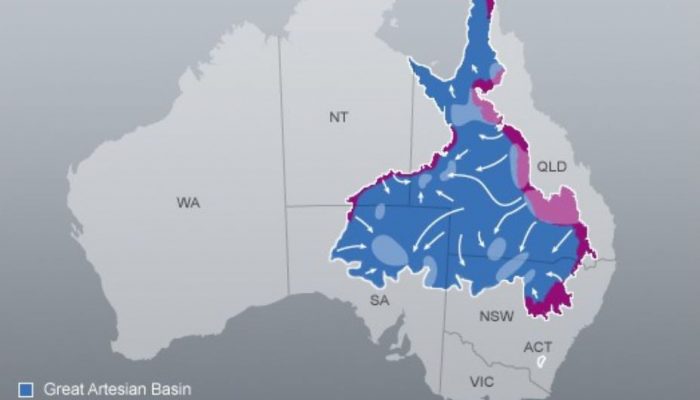
By Matthew Currell – Senior Lecturer at RMIT University
Springs, some of which have been flowing for hundreds of thousands of years, have been disappearing in Australia due to human water use over the past century. Following a hotly contested court case, Australia’s Environment Minister imposed a 20cm ‘drawdown limit’ at a set of springs, to protect them from a proposed coal mine. However, this ignores a fundamental principle of hydrogeology, known as ‘capture of discharge’ and as a result, the springs may still be under threat.
Why are springs important?
Springs are a groundwater system’s gift to the surface. They provide a constant source of water to the landscape throughout the year, and many have been doing so for millenia. This is why they are often of great importance to indigenous people and why they play an important part in the history of human settlements. Springs also provide valuable ecological refuges in dry landscapes and are often home to endemic species. However, springs are vulnerable to the effects of groundwater extraction.
The disappearing springs of the Great Artesian Basin
Recently, a group of Australian ecologists and hydrogeologists published a study of ‘lost springs’ that have disappeared from the Australian landscape since European settlers began drilling for water and minerals in the Great Artesian Basin (GAB) – the world’s largest artesian aquifer system (the term ‘artesian’ means that when a wellbore intersects one of the aquifers, groundwater flows freely to the surface, often gushing meters up into the air). Groundwater in the Great Artesian Basin travels many hundreds of kilometres across the Australian continent, before surfacing as clusters of springs, which provide life in otherwise dry landscapes (Figure 1). Research by colleagues of mine estimates that some of these springs have been discharging water (at variable rates) for hundreds of thousands of years. This is based on dating the minerals that have been continuously precipitating at the spring outlets over geologic time. The drilling of wells in the Great Artesian Basin began in the late 1800s and was encouraged by governments, as a way to ‘open up the landscape’ for further white settlement into the country’s harsh, arid interior. Many of these artesian bores were allowed to flow freely for decades (some are still uncapped), leading to major declines in groundwater pressures throughout the Great Artesian Basin. Sadly, this has also caused many springs to disappear.
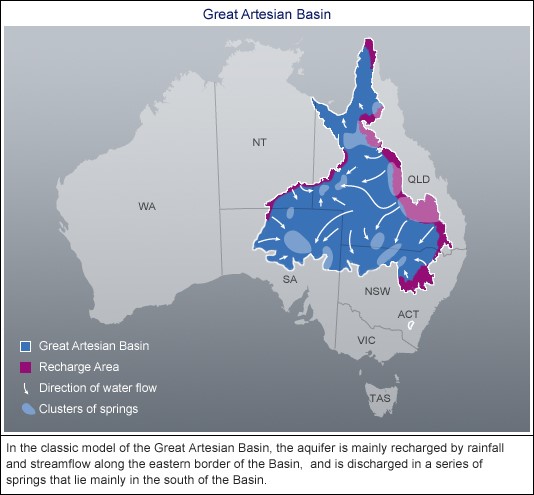
Figure 1 – Map of Australia’s Great Artesian Basin, which covers four states, showing the major areas of groundwater recharge and discharge, where springs emerge at the surface. Source: ABC Science: http://www.abc.net.au/science/articles/2012/04/04/3470245.htm
Recent threats to springs from mining
More recently, another human activity threatens springs – mining. In particular, parts of Australia have recently experienced a boom in coal seam gas and large coal mining proposals. Large volumes of groundwater must be pumped from the aquifers above and adjacent to the coal and gas deposits to allow them to be mined. Extracting groundwater for mining means that some water that could otherwise reach the surface at springs is re-directed towards the gas wells or mine pits. Figure 2 shows a map of oil and gas exploration and production permits that currently cover the Great Artesian Basin. Many of these are yet to be developed but would involve significant groundwater extraction.
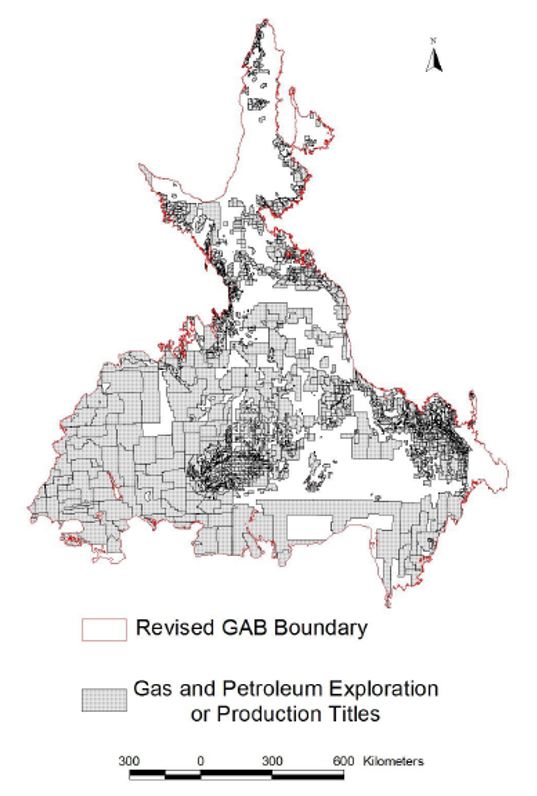
Figure 2 – Map of the Great Artesian Basin showing active oil and gas leases. From: SoilFutures Consulting, (2015): Great Artesian Basin Recharge systems and extent of petroleum and gas leases (2nd ed)
Recently, a major international company has also proposed the largest coal mine in Australia’s history – the Carmichael Coal Mine & Rail Project. Within 10 kilometres of the proposed mine site is a group of Great Artesian Basin springs – the Doongmabulla Springs. These springs are an ecological refuge, providing an oasis of green in an otherwise dry landscape (as can be seen in drone footage here: https://www.youtube.com/watch?v=RglMko3GwQA). The springs are of high cultural and ecological significance to the local Indigenous Wangan and Jagalingou people, and for this reason (among others) these people are strongly opposed to the mine.
Colleagues of mine recently participated in a hotly contested court case, arguing over whether or not the Carmichael Mine poses a threat to the survival of the Doongmabulla Springs – recognised by the Land Court judge as having ‘exceptional ecological significance’. The argument centred on whether or not the springs are fed by water from the same group of aquifers that will be excavated and de-watered by mining, or shallower aquifers. Ultimately, the Court decided that the mine was unlikely to pose an imminent threat to the springs, and upheld the environmental authority that was earlier granted by the Australian Government. This was in spite of testimony of some expert hydrogeologists that the most likely explanation for the springs is a fault that brings deep groundwater to the surface (more about the case and the mine can be read here).
Protection of Great Artesian Basin Springs
In Australia, the native flora and fauna supported by Great Artesian Basin springs are protected under the country’s highest piece of environmental legislation – the Environment Protection and Biodiversity Conservation Act (1999). This recognises the extraordinary level of endemism in these spring systems – many support species that are found in a single spring pool or group of springs, and nowhere else on earth. If a mining project is located in an aquifer that supports ‘GAB Springs’, the Act specifies that the Environment Minister must impose conditions to protect the springs’ water source. The mining company must then develop a monitoring and management plan, and a set of contingency measures to ensure impacts can be minimised.
In order to protect the Doongmabulla Springs from potential impacts of the Carmichael mine, the Environment Minister chose to apply a drawdown limit or ‘trigger’ level of no more than 20cm, stating:
“I took a precautionary approach by imposing a drawdown limit of 20 cm at the Doongmabulla Springs Complex (condition 3d), to ensure that there are no unacceptable impacts to the springs”
Problems with a drawdown ‘trigger’ to protect springs
Limiting drawdown to 20cm at a spring may sound like a strict criterion to ensure minimal impact from groundwater extraction (as this is a relatively small change in the water level). However, the approach has a number of pitfalls, as I recently outlined in a technical commentary in an article for the journal Groundwater.
The drawdown ‘trigger’, applied at the springs themselves, ignores one of the fundamental principles of hydrogeology, which is that groundwater extraction affects aquifers in two major ways; firstly through depletion of water in storage, and secondly through capture of discharge. All groundwater and surface water systems are subject to a ‘water budget’, whereby an increase in extraction at one point leads to a corresponding decrease in water stored or water available somewhere else. It has long been recognised that when groundwater extraction begins, there is generally a period in which storage depletion – shown by declining groundwater levels in the aquifer near the extraction point – is the dominant effect. However, in the long-term, extraction is balanced mostly by a decrease in the discharge reaching the surface. It is the ‘capture of discharge’ which is the most important effect to consider when protecting springs from pumping – as spring water is entirely composed of groundwater discharge. Unfortunately, this ‘capture’ is not well predicted by monitoring the amount of drawdown, particularly at the point of discharge itself.
As Figure 3 below demonstrates, it is quite possible for a spring (or a gaining stream) to experience minimal drawdown, but for the flow of water from the aquifer to the surface to decrease or even cease entirely. For this reason, by the time 20cm of drawdown has been noticed at the Doongmabulla Springs – which are located about 8 kilometres from the mine site – it is likely that the flow directions and water budget will have been fundamentally changed, and possible that the springs may ultimately cease to flow, as has occurred in many other parts of the Great Artesian Basin.

Figure 3 – Example of how groundwater levels change during groundwater extraction. Drawdown may be small at a spring or stream until it is too late (fr: Currell, 2016).
Alternative approaches to management and protection of springs
It can be argued that the setting of a drawdown ‘trigger’ at a spring or stream is a classic case of ‘reactive’ environmental management, whereby management action is taken only in response to an impact when or after it takes place. Because of the relatively high level of uncertainty in most hydrogeological systems, the time-lags that occur between an activity such as pumping and the hydrological response, and the difficulty in directly observing groundwater behaviour, a pro-active approach to monitoring and managing impacts from mining and other activities is needed. As I argue in the technical commentary, a far more effective approach to springs protection would include a program to understand the source aquifer for the springs, an assessment of the water budget before and after the mining development (through modelling), and a monitoring program that maps out water level patterns and flow directions in the aquifer(s) regularly through time and also monitors flow rates at the springs. These activities should be undertaken up-front during the environmental impact assessment. If ‘trigger’ levels are to be used as an effective management tool, these should be set as specified water levels at a series of points set back some distance from the springs, to identify negative effects before they reach the springs.
While this may sound onerous for the mining company, the importance of the springs to the indigenous people and ecological environment means that it is worth making the effort to use the best hydrogeological science possible to protect them.
Bonus Figures
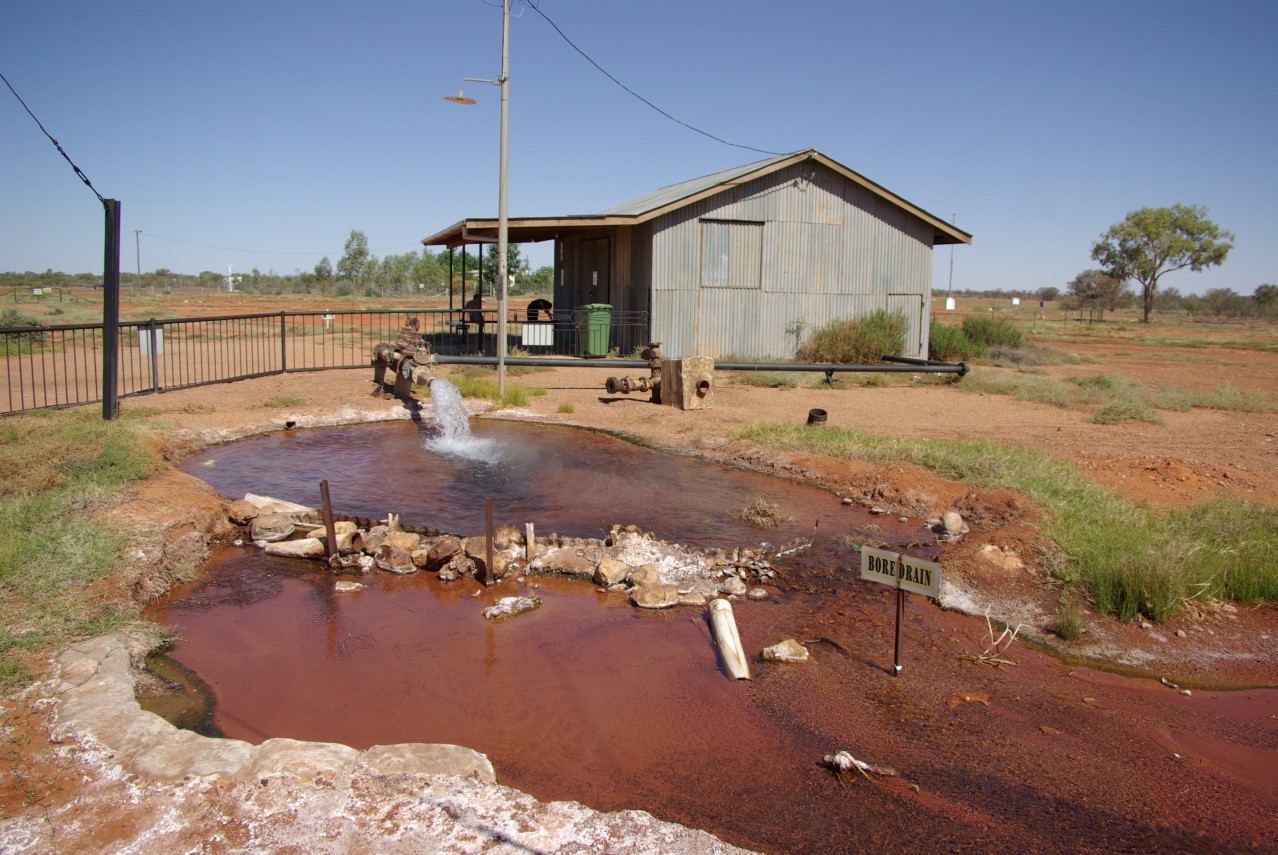
Artesian well in the Great Artesian Basin providing a constant flow of hot water. (Source: Wikipedia commons)

Evidence of springs that have gone dry, from sites in Australia’s great Artesian Basin. From: Fensham, R. et al., 2015 In search of lost springs: a protocol for locating active and inactive springs. Groundwater Volume 54, Issue 3, pagese 374-383, 5 October 2015 DOI: 10.1111/gwat12375 (link)


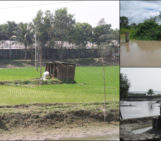
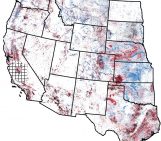

Brian Smerdon
Thanks for sharing this news about the drawdown trigger. Groundwater management in the various jurisdictions across the GAB has long been from the perspective of ‘available head’. Yet, managing to a head condition neglects the effect of timescales associated with such large flow systems, something that Bredehoeft has cautioned against over the decades (http://onlinelibrary.wiley.com/doi/10.1111/j.1745-6584.2011.00799.x/full).
As a community, we’ve also got to start moving away from that simple/romantic conceptualization of the GAB and it’s 1000+ km flow system. Lots of research from your colleagues at Flinders University, Geoscience Australia, and CSIRO point to the need to consider faulting. Complex –> YES!, but can dramatically change our perception of how different portions of this aquifer system are connected, and how stresses propagate to receptors like the famous springs. Many of the springs that Fensham et al. documented are located in a faulted portion of the GAB that almost starts to look compartmentalized when the effect of faulting is considered. And when a century of extraction is somewhat compartmentalized –> unhappy springs 🙁
Matthew Currell
Many thanks for the insightful comments Brian, all the more valuable given the great contribution you and your colleagues have made to understanding the hydrogeology of the GAB in recent years.
Water Underground readers might be interested to check out the GAB water resource assessment Brian’s group conducted for Geoscience Australia: http://www.ga.gov.au/scientific-topics/water/groundwater/gabwra/data/whole-of-gab-reports;
as well as his more recent study of the impact of faulting on flow patterns in the basin: http://link.springer.com/article/10.1007/s10040-015-1248-z
-Matthew